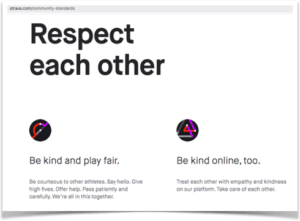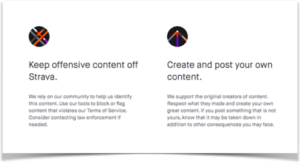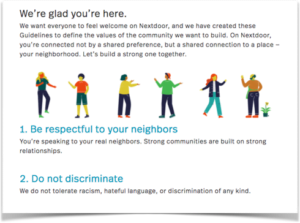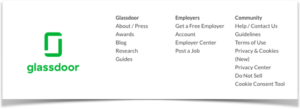From the latest video-sharing social networks to recently launched dating apps, new online communities have a common responsibility: To keep members safe through rules that are clear and fair to their respective communities.
[reit]Q2 2020 hedge fund letters, conferences and more
Failure to create guidelines protecting users can be brand-damaging, as hyperlocal social network Nextdoor learned the hard way. The neighborhood app scrambled to revise outdated guidelines after criticism of community censorship and racial profiling on the platform surfaced.
With ambiguous or nonexistent community guidelines, moderators will have to deliberate each time a post in the online community seems questionable. Without community guidelines, keeping the community safe in the event of “off” posts can be time-consuming.
Setting Online Community Guidelines
Building an online community that cultivates a positive environment for all who are part of it requires respect among the group, but to foster that, your organization will need to set some community guidelines. Here are WebPurify’s top tips for creating, communicating, and enforcing guidelines for your online community that will strengthen engagement, and in turn generate trust in your brand.
1) Write a Mission Statement
When it comes to creating and maintaining a comprehensive community guideline, the best place to start is with your mission statement. If your online community doesn’t have a mission statement, it’s time to write one.
A mission statement should communicate the purpose of your community, who it is meant to connect, how community involvement will be beneficial for every member, and how this connection will be accomplished. Additionally, the mission statement should support the values of your brand.
If you already have a mission statement, make sure that it covers these four points before moving on to the creation of your community guidelines:
a. What your organization does
b. How it accomplishes this
c. Who your organization serves
d. What value you offer to those served
Your mission statement should demonstrate what your organization’s value is to both employees and consumers. It should communicate what makes your brand unique, while being plausible and relevant.
2) Strike a Balance Between Rules and Values
It’s tempting to go heavy on the rules when crafting your community guidelines. Typically rule-based guidelines are a list of rules for users to follow, but the harshness of this approach can undermine the very connection that your online community strives to create.
Values-based guidelines, on the other hand, are much more well-received. When you define the values of your online community, you also convey inclusivity. Omitting rules for fear of offending users, however, could open doors for a lack of responsibility within the community and eventually lead to situations where members are offending other members.
Be intentional about striking a balance between rule-based and values-based guidelines by laying out the community values and following that with helpful “instructions” on how members can reinforce the values. You can even start by writing a list of rules for your brand to refer to internally, and then reframing these as a list of member responsibilities that your organization then shares online.
This can be achieved by taking that list of Do’s and Don’ts and rewording each item to
include phrases such as “we are committed to respecting each other and the guidelines.” You can also present your online community’s rules as “member expectations” detailing what is expected of members and how the community will determine if expectations are met or disregarded.
To strike a balance between rule-based and values-based guidelines, forgo writing in the negative and choose affirmative language when possible. Wording that is welcoming, inclusive, and encourages edifying conversations and engagement is ideal.
3) Provide Guidelines that are Easy to Understand… And Find
If you’re ever heard a radio ad that ends with legal terms and conditions played at hyper speed, then you know how impersonal legal jargon can be. Legalese is equally as obscure and ineffective in community guidelines.
Whether you include a User Agreement on your Community Guidelines page, or you provide a link to a separate webpage for terms from the Guidelines page, be sure to distill the terms and conditions drafted by a lawyer down to relatable, digestible language.
Remember that the words and even images of the community guideline should get users to actually read the guidelines in their entirety. To accomplish this, choose catchy subheadings, creative images, and concise, relatable wording for your community guidelines.
Once you get your users’ attention, you can direct them to further instructions and examples. In the Strava guidelines shown below, the subheading “Keep offensive content off Strava” is followed by instructions on how community members can do so by using tools to flag content or contacting law enforcement.
It is also crucial that you provide clear examples of what you mean rather than leave this up to members’ interpretations. You can achieve this by using subheadings followed by a bulleted list or explanation. For instance, after the subheading “Do not discriminate” you could give examples of what is not tolerated by your online community, including zero tolerance for racism, harassment, and other hateful conduct.
Additionally, community guidelines and policies should be incredibly easy for existing members and visitors to find. To cover all your bases, include a link to the community pages in both your site header and footer.
4) Update Guidelines and Revise Outdated Rules
In light of current issues surrounding racial inequality, it’s vital that your brand offers clarification on existing community guidelines regarding these local and national topics.
During an interview with NPR, Nextdoor CEO Sarah Friar said that the company should have responded faster than they did to community censorship by revising outdated rules.
When Nextdoor did update their guidelines, they made the wise decision to create a separate community page, dedicated solely to “Discussions about current local and national topics.” On this page, Nextdoor states that they will allow conversations in the main feed about local law enforcement’s record or policies and how these issues “affect or have affected you or people you know.”
Do your community guidelines take into consideration national conversations around movements? Be aware of these conversations and how they may impact your members, and update your guidelines accordingly… and as soon as possible.
5) Be Clear About Consequences
If your moderators take content down, it should be justified, and nothing makes removed content easier to explain than a link to your community guidelines. List the actions that will be taken in response to guideline violations and emphasize that these actions will be taken to ensure the protection of the online community’s members.
On its community guidelines, TikTok provides an extensive list of content it prohibits,
reminding its community that content promoting self-harm, slurs, spam, and hateful ideology (to name a few) is not tolerated and will be removed:
Hateful Ideology
Hateful ideologies are incompatible with the inclusive and supportive community that our platform provides. We remove content that promotes hateful ideologies.
Do not post:
- Content that promotes any hateful ideologies by talking positively about or displaying logos, symbols, flags, slogans, uniforms, salutes, gestures, portraits, illustrations, or names of individuals related to these ideologies
- Content that denies well-documented and violent events have taken place
- Music or lyrics that promote hateful ideologies
When creating or updating community guidelines, it may also be beneficial to address the following:
a. How posts that violate community guidelines will be handled (flagged or removed, etc.)
b. The penalty for first time, second time, third time offenders
c. How many violations are allowed before a ban or suspension
When it comes to what content your moderation team removes and how these removals are justified, consistency is key. You can also take a proactive approach and keep content that needs to be removed from being posted in the first place. This can be accomplished by using your guidelines to provide GUIDANCE.
Guide your online community’s dialogue through industry news that is relevant and uplifting. And demonstrate your organization’s sincerity, transparency, and commitment to creating a positive community through conversation prompts.
Conclusion
At the end of the day, your community guidelines should offer members an online environment that they are proud to be part of. Like any community, it will have its own unique challenges, so be open to members’ feedback in order to offer guidelines that reflect their needs. A thriving online community will change as it grows, and as such, guidelines will need to be revised.
To create a positive atmosphere for all members of your online community, encourage respect by setting, communicating, and enforcing community guidelines. The result will be a healthy community and trust in the brand that’s behind it.









